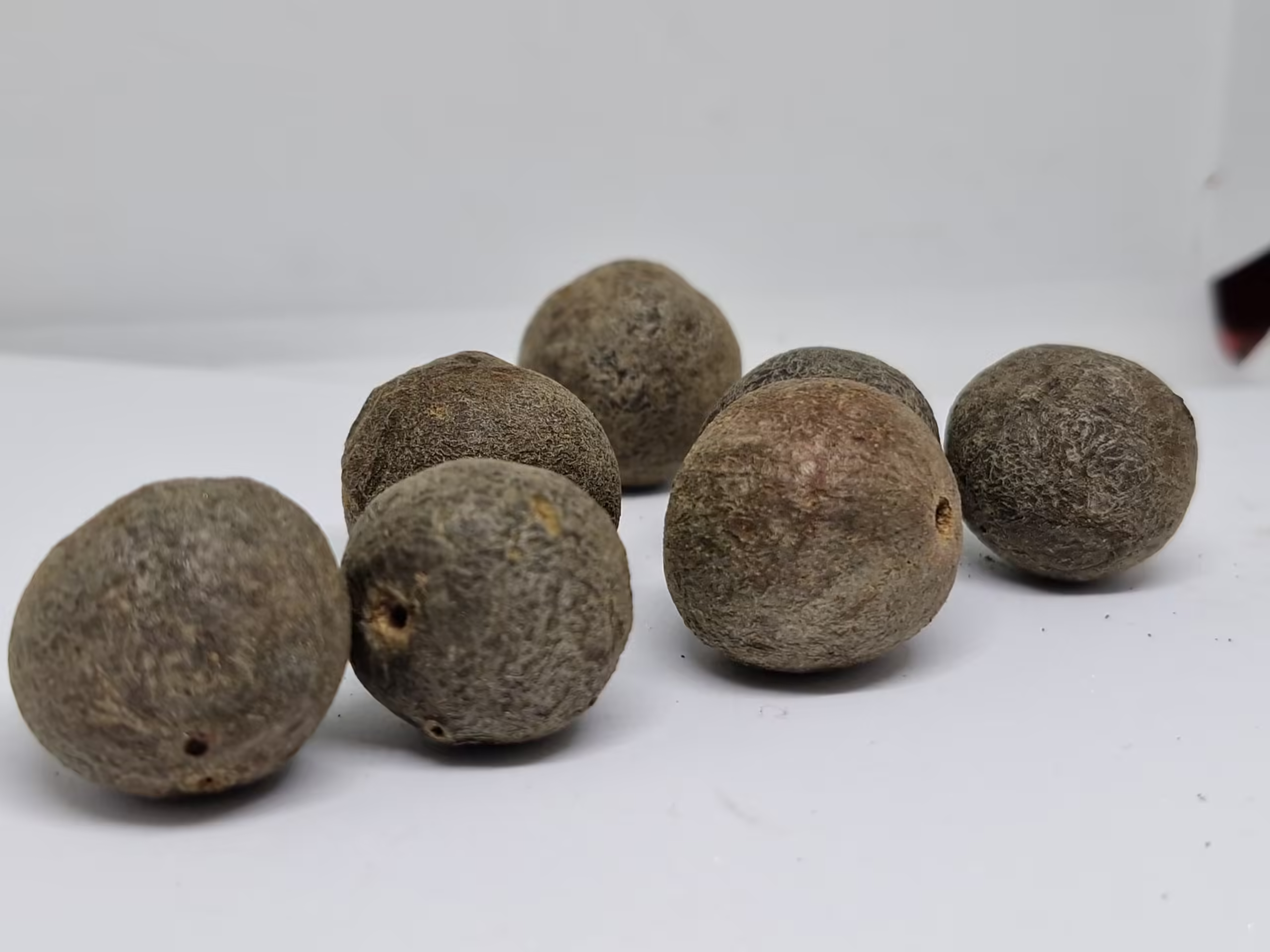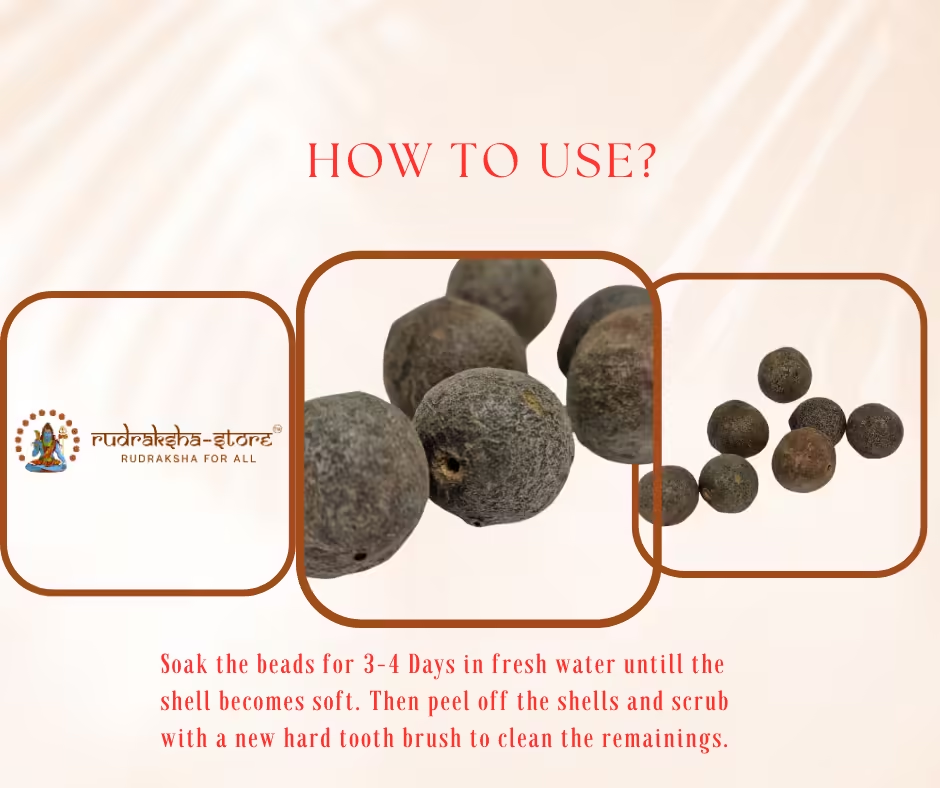Rudraksha Fruits Nepal Natural Raw Rudraksha Fruit (Original Untreated)- Natural Brown Rudraksh (Big Size) Pack of 5 Rudraksha
- Authentic Origin: Sourced directly from the highlands of Nepal, ensuring genuine quality and spiritual significance.
- Untreated: Maintains its natural, unprocessed state for an authentic experience.
- Unique Pattern: Each bead features distinct natural patterns and textures, making every piece unique.
- Personal Reflection: Useful as a sacred item for personal introspection and growth.
The Rudraksha, revered in Hinduism and Buddhism, is believed to be a divine gift from Lord Shiva himself, symbolizing the ultimate connection between the earthly and spiritual realms. Our product, the Natural Raw Rudraksha Fruit, represents the unadulterated essence of this sacred bead. Untreated and in its natural state, this Rudraksha fruit retains all its original properties and energy, offering you an authentic experience that is both spiritually uplifting and physically beneficial. One of the most striking features of this Rudraksha fruit is its impressive size. Unlike the smaller beads commonly available, our offering is notably larger, making it highly desirable for those who seek a more substantial and impactful Rudraksha. The size of the Rudraksha bead is significant not only for its visual appeal but also for its enhanced ability to serve as a powerful tool in meditation and spiritual practices. The larger size allows for a more comfortable grip and a more pronounced presence, which can be particularly beneficial for those who incorporate Rudraksha beads into their daily routines.
In stock
Original price was: ₹499.00.₹151.00Current price is: ₹151.00.
Hurry up! Sale end in:
In stock
Introduction to Rudraksha Fruits
Rudraksha fruits, known for their distinctive seed beads, are derived from the seeds of the Elaeocarpus ganitrus tree, commonly found in the Himalayan regions, particularly in Nepal, India, and Indonesia. The term ‘Rudraksha’ translates to ‘the eyes of Rudra’, referring to Lord Shiva in Hinduism, highlighting the deep spiritual significance attributed to these fruits. The Rudraksha tree is a tall evergreen that thrives in subtropical climates, reaching heights of up to 60 feet. The trees typically grow at elevations ranging from 1,200 to 3,000 meters, making the diverse terrains of Nepal an ideal habitat for their cultivation.
The unique appearance of the Rudraksha fruits, characterized by their dark, wrinkled surface, is what makes them noteworthy. Each seed has a specific number of facets known as ‘mukhis’, and these can range from one to twenty-one, determining their value and spiritual significance in various practices. Upon harvesting, the fleshy outer layer of the fruit is removed to reveal the seed, which is then dried under sunlight to enhance its durability.
Rudraksha fruits hold immense cultural and spiritual importance, particularly in Hinduism and Buddhism. These fruits are often used as malas or prayer beads, symbolizing a connection to divine energies and aiding in meditation practices. Devotees believe that wearing or using Rudraksha beads can confer numerous benefits, including emotional stability, protection from negative energies, and a pathway toward spiritual growth. The rich heritage surrounding the Rudraksha extends beyond mere accessory, embedding itself deeply into the religious practices across various regions.
The Biological and Ecological Aspects
Rudraksha fruits, renowned for their spiritual significance, possess intriguing biological characteristics. These fruits, derived from the tree known as *Elaeocarpus ganitrus*, appear as small, round berries that vary in color from green to dark brown when fully mature. The outer layer is often coarse, rich in texture, and encases a hard inner seed that is recognizable by its distinctive furrows, which are categorized into different mukhis or facets. This made the seeds highly sought after for their purported energetic properties and use in traditional mala prayer beads.
The taste of Rudraksha fruits is generally described as slightly astringent and not traditionally consumed as food, although local populations sometimes make use of the flesh for medicinal purposes. Rudraksha trees flourish in the sub-tropical climates of Nepal, thriving at altitudes ranging from 1,200 to 1,800 meters. They prefer well-drained soils that are rich in organic matter and benefit from adequate rainfall, contributing to their sustainable growth cycle. From germination to fruiting, the life cycle of the Rudraksha tree typically spans several years, requiring specific environmental conditions to reach maturity.
Ecologically, Rudraksha trees play an essential role within their habitat. They provide shelter and food for various wildlife species, contributing to biodiversity. Their presence aids in soil conservation and helps mitigate erosion in hilly regions of Nepal. However, increasing demand for Rudraksha seeds and the fruits has led to overharvesting, raising concerns about sustainability. Conservation efforts have begun to take shape, focusing on responsible harvesting practices and promoting planting initiatives to ensure that this valuable species remains an integral part of Nepal’s ecosystem. Such initiatives aim to balance ecological health with cultural and economic benefits, ensuring the continued legacy of Rudraksha fruits in Nepal.
Harvesting and Processing of Raw Rudraksha Fruits
The harvesting of rudraksha fruits is a meticulous and culturally significant process primarily conducted in the monsoon months of June to August. During this period, the fruits reach their peak ripeness, characterized by a rich, deep hue that indicates their readiness for collection. Local farmers and gatherers typically engage in this endeavor, employing traditional techniques and tools that have been passed down through generations. The primary tool utilized for harvesting is a simple hand-held knife, which allows for precise cutting of the ripe fruits from the rudraksha trees without damaging the branches or the delicate skin of the fruit.
Once harvested, the raw rudraksha fruits are carefully transported to processing centers, often located within the community. These facilities are equipped with the necessary tools to enhance the transformation of raw fruits into the renowned rudraksha beads prized for various spiritual and health benefits. The initial step in processing involves cleaning the fruits thoroughly to remove any impurities, followed by the extraction of the seeds from the fleshy outer layer. This extraction process is crucial, as the seeds, once dried, will ultimately form the beads.
Cultural practices play a vital role in both the harvesting and processing of rudraksha fruits. In many local communities, harvesting is accompanied by rituals and traditions that honor the sacred significance of the rudraksha tree, believed to be associated with spiritual growth and meditation. Local farmers often invoke blessings for a bountiful harvest and protection against misfortune, emphasizing the deep-rooted connection between the community and their natural resources. This blending of agricultural practice with spiritual reverence not only supports the local culture but also promotes sustainable harvesting methods that ensure the continued availability of rudraksha fruits for generations to come.
Health Benefits and Uses of Rudraksha Fruits
Rudraksha fruits have been revered for centuries, particularly in Hindu and Buddhist traditions, for their extensive health benefits and spiritual significance. Believed to possess unique energy and vibrational properties, these fruits are thought to aid various aspects of mental and physical well-being. One of the most prominent claims is their ability to alleviate stress and anxiety, promoting mental clarity and emotional stability. Furthermore, some studies suggest that the consumption of Rudraksha fruits may positively impact the nervous system, potentially leading to improved mood and cognitive functions.
Beyond mental health, Rudraksha fruits are also associated with spiritual enhancement. They are commonly used during meditation practices, where they are believed to deepen the user’s focus and connection to the divine. The act of wearing or holding Rudraksha beads during meditation not only brings a sense of tranquility but also serves to ground the practitioner, helping in the overall experience of spiritual growth and enlightenment. Additionally, these fruits are often viewed as tools for enhancing one’s energy levels and promoting physical health.
From a nutritional standpoint, Rudraksha fruits are rich in several beneficial compounds, including antioxidants, which can combat oxidative stress in the body. However, it is essential to approach their use with caution, as further scientific research is still needed to fully understand their effects on human health. In holistic practices, Rudraksha is frequently incorporated into therapies involving yoga and mindfulness, reinforcing its role in promoting a balanced lifestyle. The versatility and therapeutic potential of Rudraksha fruits are indeed noteworthy, establishing them as a valuable element within traditional medicine and modern wellness paradigms.
Conclusion
The cultural and spiritual significance of Rudraksha in Nepal is deeply rooted in the traditions and practices of its people. Revered for centuries, these sacred fruits are not merely physical items, but powerful symbols of spirituality that reflect the rich heritage of Nepalese society. Traditionally, Rudraksha beads are used in meditation and prayer, believed to enhance spiritual growth and bring peace to the mind and body. Each bead is associated with various deities and is thought to possess unique properties that cater to multiple aspects of life, serving as a vital link between the spiritual and the physical realms.
In Nepal, Rudraksha is not just a product of nature but also an essential component of community life. It plays a crucial role in rituals, festivals, and daily practices, fostering a sense of unity among individuals who share a common belief in its benefits. The cultivation of these fruits has provided livelihood opportunities for many local farmers, contributing significantly to the rural economy. However, the growing global demand for Rudraksha poses potential challenges, such as overharvesting and environmental degradation. To sustain this valuable resource, communities must prioritize conservation strategies, ensuring that Rudraksha cultivation remains both ecologically viable and economically beneficial.
As we look to the future, it is essential to acknowledge the evolving market trends surrounding Rudraksha. The increasing interest from consumers worldwide necessitates a balanced approach that values both cultural heritage and environmental sustainability. By fostering awareness and education around the significance of Rudraksha, Nepal can ensure that this natural treasure continues to thrive for generations to come. In conclusion, the Rudraksha fruit represents much more than a mere commodity; it encapsulates the spirit, traditions, and aspirations of the Nepalese people, forging a timeless bond between the natural and spiritual world.
| Weight | 0.4 kg |
|---|---|
| Dimensions | 10 × 10 × 10 cm |
Only logged in customers who have purchased this product may leave a review.







Reviews
There are no reviews yet.